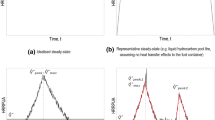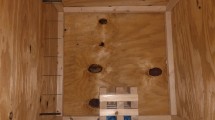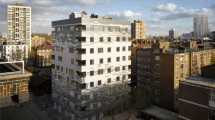Abstract
In this study, the spreading of cough droplets emitted by an infected person in a bodybuilding salon in the presence of an air curtain system was investigated using computational fluid dynamics (CFD) simulations. The RNG k-ε model was used to simulate turbulent airflows in the bodybuilding salon. The Eulerian–Lagrangian model was used for cough droplet dispersion simulation. This study introduced various innovative elements that contributed to advancing the field. First, it presented a groundbreaking air curtain flow pattern designed for bodybuilding salons. Second, the study employed user-defined functions (UDFs) to model airflow containing cough droplets and their evaporation, providing a comprehensive understanding of droplet behavior. Third, the risk of infection was evaluated using the Wells–Riley equation and then the effect of relative humidity on droplet evaporation in bodybuilding salons. Air curtain flow pattern, requiring no structural changes to the building while optimizing energy consumption, preventing the spread of viruses and dust, and ensuring fresh air circulation throughout the salon, can be implemented in various public and private spaces. The air curtains were generated using two narrow inlets at the ceiling with floor-level outlets to separate the indoor environments into compartments with limited mass transfers but unlimited access through the opening between these spaces. The simulation results showed that when the air curtain ventilation system was used, 60s after the cough, the average cough droplet concentrations in some areas are at nearly 5%. There were no droplets in the bodybuilding salon after the 90s and the virus-carrying droplets stayed in the space between the air curtains and did not spread in the salon. The study evaluates the risk using the Wells–Riley equation of infection for individuals in the bodybuilding salon, providing valuable insights into the potential vulnerabilities and the need for precautions in this setting. The infection risk of a healthy person in areas A1, A4, and A7 is 21%, 33%, and 25%, respectively, but in areas A2, A3, and A5–A9, the infection risk is less than 1%. The reason is that the airflow pattern created by the air curtain reduces or prevents the spread of virus-carrying droplets to the other compartment generated by the air curtains and also makes the environment safer. These findings significantly enhanced safety measures and controlled droplet spread in these indoor spaces.
Graphical Abstract















Similar content being viewed by others
Data availability
No new experimental data are provided in this manuscript.
Abbreviations
- A :
-
Surface area (m2)
- A C :
-
Average droplet concentration (Kg/m3)
- A i :
-
I-The area (i = 1,2,..,8)
- A N :
-
Number of particles
- V A :
-
Velocity average in domain solving flow (m/s)
- v(x, t):
-
Droplet concentration
- C C :
-
Cunningham coefficient (-)
- C i,s :
-
Vapor concentration at the particle surface (kg mol/m3)
- C i,∞ :
-
Vapor concentration in the bulk gas (kg mol/m3)
- C p :
-
Specific heat capacity (J/kg K)
- cp:
-
Quanta number density in droplets (-)
- d :
-
Droplets diameter (μm)
- D i,m :
-
Diffusion coefficient of vapor (m2/s)
- F B :
-
Brownian force (-)
- F D :
-
Drag factor (-)
- FTH :
-
Thermophoretic force (-)
- F L :
-
Saffman lift force (-)
- f(t):
-
Viability of the virus
- ṁp:
-
Flow rate (kg/s)
- G :
-
Gravity (m/s2)
- g :
-
Gravitational acceleration components (m/s2)
- h :
-
Convective heat transfer coefficient (W/m2-K)
- h fg :
-
Latent heat (J/kg)
- I :
-
Number of infectors (-)
- I I :
-
Injection time (s)
- K T :
-
Fluid thermal conductivity (W/m K)
- k C :
-
Mass transfer coefficient (m/s)
- M w,i :
-
The molecular weight of species i (kg/kg mol)
- m :
-
Mass (kg)
- N :
-
Number of droplets (-)
- Nu:
-
Nusselt number (hl/ka)
- N i :
-
Molar flux of vapor (kg mol/m2-s)
- N T :
-
Total number of droplets (-)
- N t :
-
Droplets at each time (-)
- \(N\) Tn :
-
Droplets remaining in the dental clinic (-)
- \({N}_{{\text{m}}}\) :
-
Number of meshes (-)
- Ns:
-
Total number of quanta (-)
- P :
-
Pressure (Pa)
- PRT:
-
Particle residence time (s)
- P op :
-
Operating pressure (pa)
- ρ :
-
Breathing rate per person (m3/s)
- \({\rho }_{{\text{d}}}\) :
-
Density of droplets
- Q :
-
Air supply rate (m3/s)
- q :
-
Quantum generation rate (quanta/s)
- R :
-
Universal gas constant (J/kg.K)
- Re:
-
Reynolds number (-)
- RH:
-
Relative humidity (-)
- P rt :
-
Particle removal time (s)
- m :
-
Mass (kg)
- S :
-
Number of susceptible (-)
- Sc:
-
Schmidt number (-)
- S T :
-
Source term (C)
- t :
-
Time (s)
- T :
-
Temperature conditions (C)
- u, v, w :
-
Velocity components (m/s)
- G k, S ε, S k, α k, α ε, R ε, \({C}_{1\varepsilon }\) , \({C}_{2\varepsilon }\) :
-
Turbulent kinetic energy and model constants (-)
- V v :
-
Ventilation velocity (m/s)
- V :
-
Velocity vector (m/s)
- W :
-
Water mass fraction (Kg/mol)
- X, Y :
-
Non-dimensional Cartesian coordinates (-)
- α :
-
Thermal diffusivity (m2/s)
- ε :
-
Dissipation rate of the turbulent energy (-)
- μ T :
-
Dynamic viscosity (m2/s)
- η :
-
Particle removal efficiency (-)
- ρ :
-
Density (kg/m3)
- sat:
-
Saturation (-)
- T:
-
Total (-)
- x,y,z :
-
Cartesian directions (-)
References
World Health Organization. (2021). Infection prevention and control during health care when coronavirus disease (COVID-19) is suspected or confirmed: interim guidance, 12 July 2021 (No. WHO/2019-nCoV/IPC/2021.1). World Health Organization.
R. Zhang, Y. Li, A.L. Zhang, Y. Wang, M.J. Molina, Identifying airborne transmission as the dominant route for the spread of COVID-19. Proc. Natl. Acad. Sci. 117(26), 14857–14863 (2020)
L. Morawska, J. Cao, Airborne transmission of SARS-CoV-2: The world should face the reality. Environ. Int. 139, 105730 (2020)
X. Li, Y. Shang, Y. Yan, L. Yang, J. Tu, Modelling of evaporation of cough droplets in inhomogeneous humidity fields using the multi-component Eulerian-Lagrangian approach. Build. Environ. 128, 68–76 (2018)
H.C. Yu, K.W. Mui, L.T. Wong, H.S. Chu, Ventilation of general hospital wards for mitigating infection risks of three kinds of viruses including Middle East respiratory syndrome coronavirus. Indoor Built Environ. 26(4), 514–527 (2017)
L. Zhang, Y. Li, Dispersion of coughed droplets in a fully-occupied high-speed rail cabin. Build. Environ. 47, 58–66 (2012)
N. Baker, G. Kelly, P.D. O’Sullivan, A grid convergence index study of mesh style effect on the accuracy of the numerical results for an indoor airflow profile. Int. J. Vent. 19(4), 300–314 (2020)
J. Redrow, S. Mao, I. Celik, J.A. Posada, Z.G. Feng, Modeling the evaporation and dispersion of airborne sputum droplets expelled from a human cough. Build. Environ. 46(10), 2042–2051 (2011)
Y. Yan, X. Li, J. Tu, Thermal effect of human body on cough droplets evaporation and dispersion in an enclosed space. Build. Environ. 148, 96–106 (2019)
A. A. Aliabadi, S. N. Rogak, S. I. Green, K. H. Bartlett, (2010). CFD simulation of human coughs and sneezes: a study in droplet dispersion, heat, and mass transfer. in: ASME International Mechanical Engineering Congress and Exposition (Vol. 44441, pp. 1051–1060)
J. Ren, Y. Wang, Q. Liu, Y. Liu, Numerical study of three ventilation strategies in a prefabricated COVID-19 inpatient ward. Build. Environ. 188, 107467 (2021)
C.Y.H. Chao, M.P. Wan, L. Morawska, G.R. Johnson, Z.D. Ristovski, M. Hargreaves, S. Corbett, Y. Li, X. Xie, D. Katoshevski, Characterization of expiration air jets and droplet size distributions immediately at the mouth opening. J. Aerosol Sci. 40(2), 122–133 (2009)
W. Che, J. Ding, L. Li, Airflow deflectors of external windowsto induce ventilation: towards COVID-19 prevention and control. Sustain. Cities Soc. 77, 103548 (2022)
M. Shirzadi, Y. Tominaga, P.A. Mirzaei, Experimental and steady-RANS CFD modelling of cross-ventilation in moderately-dense urban areas. Sustain. Cities Soc. 52, 101849 (2020)
N.P. Gao, J.L. Niu, Modeling particle dispersion and deposition in indoor environments. Atmos. Environ. 41(18), 3862–3876 (2007)
K. Sirén, Technical dimensioning of a vertically upwards blowing air curtain—part I. Energy Build. 35(7), 681–695 (2003)
S. Yang, H. Alrawashdeh, C. Zhang, D. Qi, L.L. Wang, T. Stathopoulos, Wind effects on air curtain performance at building entrances. Build. Environ. 151, 75–87 (2019)
A. Khayrullina, B. Blocken, M.O.M. de Almeida, T. van Hooff, G. van Heijst, Impact of a wall downstream of an air curtain nozzle on air curtain separation efficiency. Build. Environ. 197, 107873 (2021)
N.K. Jha, D. Frank, P.F. Linden, Contaminant transport by human passage through an air curtain separating two sections of a corridor: Part I-Uniform ambient temperature. Energy Build. 236, 110818 (2021)
S.S. Diwan, S. Ravichandran, R. Govindarajan, R. Narasimha, Understanding transmission dynamics of COVID-19-type infections by direct numerical simulations of cough/sneeze flows. Trans. Indian Nat. Acad. Eng. 5, 255–261 (2020)
T.H. Shih, W.W. Liou, A. Shabbir, Z. Yang, J. Zhu, A new k-ε eddy viscosity model for high Reynolds number turbulent flows. Comput. Fluids 24(3), 227–238 (1995)
J. Wang, L. Sun, M. Zou, W. Gao, C. Liu, L. Shang, Y. Zhao, Bioinspired shape-memory graphene film with tunable wettability. Sci. Adv. 3(6), e1700004 (2017)
Y.Y. Li, J.X. Wang, X. Chen, Can a toilet promote virus transmission? From a fluid dynamics perspective. Phys. Fluids 32(6), 065107 (2020)
A. Li, G. Ahmadi, Dispersion and deposition of spherical particles from point sources in a turbulent channel flow. Aerosol Sci. Technol. 16(4), 209–226 (1992)
Y.P. Chen, Z.L. Deng, Hydrodynamics of a droplet passing through a microfluidic T-junction. J. Fluid Mech. 819, 401–434 (2017)
C. Zhang, S. Wu, F. Yao, Evaporation regimes in an enclosed narrow space. Int. J. Heat Mass Transf. 138, 1042–1053 (2019)
M.J. O’Connell, P. Boul, L.M. Ericson, C. Huffman, Y. Wang, E. Haroz, C. Kuper, J. Tour, K.D. Ausman, R.E. Smalley, Reversible water-solubilization of single-walled carbon nanotubes by polymer wrapping. Chem. Phys. Lett. 342(3–4), 265–271 (2001)
B. E. Poling, J. M. Prausnitz, J. P. O’connell, (2001). Properties of gases and liquids. McGraw-Hill Education
L. Landy, Reviewing the musicology of electroacoustic music: a plea for greater triangulation. Organised Sound 4(1), 61–70 (1999)
A. Jose, M.S. Thibodeaux, Institutionalization of ethics: the perspective of managers. J. Bus. Ethics 22(2), 133–143 (1999)
H.T. Dao, K.S. Kim, Behavior of cough droplets emitted from Covid-19 patient in hospital isolation room with different ventilation configurations. Build. Environ. 209, 108649 (2022)
S. Balachandar, S. Zaleski, A. Soldati, G. Ahmadi, L. Bourouiba, Host-to-host airborne transmission as a multiphase flow problem for science-based social distance guidelines. Int. J. Multiph. Flow 132, 103439 (2020)
W. F. Wells, (1955). Airborne contagion and air hygiene. an ecological study of droplet infections. airborne contagion and air hygiene. an ecological study of droplet infections.
E.C. Riley, G. Murphy, R.L. Riley, Airborne spread of measles in a suburban elementary school. Am. J. Epidemiol. 107(5), 421–432 (1978)
Y. Yang, Y. Wang, L. Tian, C. Su, Z. Chen, Y. Huang, Effects of purifiers on the airborne transmission of droplets inside a bus. Phys. Fluids 34(1), 017108 (2022)
S.L. Miller, W.W. Nazaroff, J.L. Jimenez, A. Boerstra, G. Buonanno, S.J. Dancer, J. Kurnitski, L.C. Marr, L. Morawska, C. Noakes, Transmission of SARS-CoV-2 by inhalation of respiratory aerosol in the Skagit Valley Chorale super spreading event. Indoor Air 31(2), 314–323 (2021)
V. Deprédurand, G. Castanet, F. Lemoine, Heat and mass transfer in evaporating droplets in interaction: influence of the fuel. Int. J. Heat Mass Transf. 53(17–18), 3495–3502 (2010)
R.M. Effros, K.W. Hoagland, M. Bosbous, D. Castillo, B. Foss, M. Dunning, M. Gare, W. Lin, F. Sun, Dilution of respiratory solutes in exhaled condensates. Am. J. Resp. Critical Care Med. 165(5), 663–669 (2002)
Y.M. Bar-On, A. Flamholz, R. Phillips, R. Milo, Science Forum: SARS-CoV-2 (COVID-19) by the numbers. Elife 9, e57309 (2020)
J.K. Gupta, C.H. Lin, Q. Chen, Flow dynamics and characterization of a cough. Indoor Air 19(6), 517–525 (2009)
W. Lu, A.T. Howarth, N. Adam, S.B. Riffat, Modelling and measurement of airflow and aerosol particle distribution in a ventilated two-zone chamber. Build. Environ. 31, 417–423 (1996)
I. B. Celik, U. Ghia, P.J. Roache, C.J. Freitas. (2008). Procedure for estimation and reporting of uncertainty due to discretization in CFD applications. J. Fluids Eng. Trans. ASME. 130(7)
Acknowledgements
This research was supported by the Brain Pool program funded by the Ministry of Science and ICT through the National Research Foundation of Korea (grant number). (NRF-2022H1D3A2A02090885).
Author information
Authors and Affiliations
Corresponding author
Rights and permissions
Springer Nature or its licensor (e.g. a society or other partner) holds exclusive rights to this article under a publishing agreement with the author(s) or other rightsholder(s); author self-archiving of the accepted manuscript version of this article is solely governed by the terms of such publishing agreement and applicable law.
About this article
Cite this article
Karami, S., Lakzian, E. & Ahmadi, G. Use of air curtains for creating safe areas in bodybuilding salons for controlling the spread of SARS-CoV-2-carrying respiratory droplets. Eur. Phys. J. Plus 139, 87 (2024). https://doi.org/10.1140/epjp/s13360-024-04899-5
Received:
Accepted:
Published:
DOI: https://doi.org/10.1140/epjp/s13360-024-04899-5




